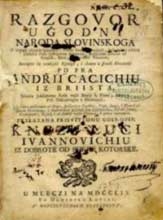Web catalog
Most read
Most read last 7 days
Most Discussed
Top rated
Statistics
- Total registered users: 9565
- Total articles: 23656
- Total comments: 2087
- Last entry: Kebo presenting evidence that Izetbegovic brought mujahideen to Bosnia
- Last update: 11.01.2019. 23:44
1700 to 1900 Expansion of the Štokavian vernacular influence Illyrian movement, final scriptory reform and language unification
Written 08.12.2009. 10:24
 Through the major part of the 18th century two seemingly contradictory processes had been under way: envigoration of literary activity in two Croatian dialects, Kajkavian (in the north-western part of Croatia) and Štokavian (in the rest of Croatia and in Bosnia); also, penetration of Štokavian influence on Kajkavian writers and local idiom. However, political and demographic factors again played the pivotal role: since the major parts of contemporary Croatia (Slavonia and Dalmatia) were liberated from Ottomans at the end of 17th century, these areas, where Štokavian dialect predominated, became centres of vigorous literary activity, mainly in the spirit of dominant Enlightenment and nascent Sentimentalism. Two enormously popular authors, a military officer from Slavonia
Through the major part of the 18th century two seemingly contradictory processes had been under way: envigoration of literary activity in two Croatian dialects, Kajkavian (in the north-western part of Croatia) and Štokavian (in the rest of Croatia and in Bosnia); also, penetration of Štokavian influence on Kajkavian writers and local idiom. However, political and demographic factors again played the pivotal role: since the major parts of contemporary Croatia (Slavonia and Dalmatia) were liberated from Ottomans at the end of 17th century, these areas, where Štokavian dialect predominated, became centres of vigorous literary activity, mainly in the spirit of dominant Enlightenment and nascent Sentimentalism. Two enormously popular authors, a military officer from Slavonia Matija Relković and Dalmatian Fransciscan friar Andrija Kačić Miošić, became a sort of cult writers in the 18th century: their works, steeped in didacticism, folk wisdom and glorification of heroic (frequently imaginary) epic past, although cannot be, on aesthetic level, compared to best Croatian writing in the Renaissance and Baroque periods, played crucial role in the spread of neo-Štokavian dialect. They, along with numerous other writers and lexicographers from Slavonia, Dalmatia and Bosnia (although still under Turkish rule, Croats in Bosnia and Herzegovina were ecclesiastically united with their compatriots in Slavonia and Dalmatia in one Franciscan province, Bosnia Argentina) set the scene for incipient «Illyrians»: the Baroque Slavism had created ornate and expressive idiom, but it was Kačić Miošić who, in his «Razgovor...»/»Discourse...» produced the summa of Croatian folk mythologies, integrated images of heroic, one might say Homeric past with the mundane purpose of Christian propaganda and gave to the Croatian people the first truly national book, unsurpassable bestseller that crossed regional, dialectal and class boundaries.
The Illyrian movement, 1830-1850, centred in Croatia\\\'s capital Zagreb (where Kajkavian dialect predominated) and lead by Ljudevit Gaj, accomplished final cultural unification of Croatian people. This movement, also called Croatian national revival, was one among many similar European movements in the «spring of nations» following the period of Napoleonic wars. In the case of Croatian revival, it was also the continuation of Ritter-Vitezović\\\'s scriptory reform and ideological pan-Croatism and Kačić Miošić\\\'s glorification of epic past, celebrated in verses paradigmatic of neo-Štokavian idiom. Its results in the field of language and linguistics can be summarized thus: «Illyrians» had given the final form of Croatian Latin script by adopting Czech and Polish diacritical marks and inventing a few exclusively Croatian graphemes and, by opting for the most widespread dialect among the Croats, Štokavian, had unified all Croats in one Croatian literary koine. Moreover, motivated by nuanced and far-sighted cultural politics, Illyrian central figures (politician and philologist Ljudevit Gaj, lexicographer, poet and politician Ivan Mažuranić, writer and polymath Ivan Kukuljević and philologist Vjekoslav Babukić) chose što-ije dialect as the basis of Croatian koine, instead of što-i, the native language-dialect of the majority of Croats. The reasons for such a decision were:
the literature written in što-ije dialect, from 1500s on, has been the richest among Croatian regional literatures (and in many ways «older» than other, recently more developed «antagonist» literatures like German: of course, no Croatian poet of the time could «compete» with Goethe or Novalis) and could be used as the strong shield against German and Hungarian language «imperialism»- in the climate of Romanticism, the claims of «antiquity» of a national literature were particularly important. The «Illyrians» have, by adopting and further developing što-ije dialect and by elevating it to the status of Croatian official language (so far as circumstances in Habsburg Empire permitted) effectively halted Germanization (and other possible de-Croatization programs).
The «Illyrians» worked in the climate of romantic Pan-Slavism that viewed all South Slavic languages as offshoots of one, «Illyrian language». Since Serbs, the geographically closest «Illyrian tribe», spoke što-e and što-ije dialects, and Croats što-i and što-ije dialects, the only possible «intersection» was što-ije dialect. However, the history\\\'s final verdict was ironic: Serbs, who didn\\\'t have a cultural tradition in što-ije dialect abandoned it for standard language based on more popular and widespread što-e dialect. On the other hand, post-medieval Croatian cultural and linguistic identity, formed in the 16th and 17th centuries, definitely crystallized around što-ije based standard language. «Illyrian» and South Slavic illusions of linguistic unity of South Slavs had not passed the reality check.
The Illyrian movement and its successor, the Zagreb philological school, have been particularly successful in creating the corpus of Croatian terminology that covered virtually all areas of modern civilization. In short- they extended and systematized the purist tendencies already present in the by then more than 400 years old Croatian vernacular literature and lexicography. This was especially visible in two fundamental works: Ivan Mažuranić\\\'s and Josip Užarević\\\'s:"German-Croatian dictionary" from 1842 and Bogoslav Šulek\\\'s "German-Croatian-Italian dictionary of scientific terminology", 1875. These works, particularly Šulek\\\'s, systematized (ie., collected from older dictionaries), invented and coined Croatian terminology for the 19th century jurisprudence, military schools, exact and social sciences, as well as numerous other fields (technology and commodities of urban civilization). So, the “Illyrians” assimilated and expanded central Croatian linguistic traits: strong loyalty and respect towards Croatian literary and philological heritage combined with linguistic purism and word-coinage. The only field where “Illyrians” partially failed was orthography: they, contrary to the tradition of mainly phonemic Croatian orthography (from 1200s on), which is best suited for a “transparent” language like Croatian (or Latin, Spanish or Italian) adopted, in the spirit of pan-Slavism, predominantly morphonological orthography (better suited for “intransparent” languages like Czech or Polish). But, this was a minor setback (later corrected by orthographic manual authored by Ivan Broz in 1892) compared to their triumphs in the vital areas of scriptory unification, definite language standardization based on što-ije dialect and continuation and extension of dominant tendencies embedded in Croatian literary and linguistic tradition.
The 19th century language development overlapped with the upheavals that befell Serbian language. It was Vuk Stefanović Karadžić, an energetic and resourceful Serbian language and culture reformer, whose scriptory and orthographic stylization of Serbian Cyrillic script and reliance on folk idiom made a radical break with the past; until his activity in the first half of the 19th century, Serbs had been using Serbian variant of Church Slavonic and hybrid Russian-Slavonic language. His “Serbian Dictionary”, published in Vienna 1818 (along with the appended grammar), was the single most significant work of Serbian literary culture that shaped the profile of Serbian language (and, the first Serbian dictionary and grammar until then). Karadžić chose što-ije dialect as the basis for emerging Serbian standard language (although virtually all works (covering the fields of literature, lexicography and philology) written in što-ije dialect in 350 years preceding his reforms belonged to the Croatian culture and were, logically, considered by eminent contemporary Serbian scholars as something alien and non-Serb) because, as a folklorist, he was impressed by the folk poetry idiom (Serbian, Croatian and Bosnian Muslim) expressed in što-ije dialect. Although the majority of Karadžić\\\'s reforms triumphed among Serbs after a struggle that lasted more than 5 decades- his choice of što-ije dialect as the basis for standard Serbian was largely abandoned. A small part of Serbs still uses što-ije based Serbian literary language, but the “variant” based on što-e is vastly predominant among Serbs. Karadžić\\\'s work was the revolution for Serbs; yet his influence on Croatian language was only one of the reforms, mostly in some aspects of grammar and orthography since the majority of his innovations had been present in Croatian literary and linguistic corpora for centuries.
But- now has begun the process that entangled Croats and Serbs in the unstable situation of two nations sharing virtually the same language according to genetic linguistics- but having frequently divergent political aims. Due to the fact that both languages shared the common basis of South Slavic neo-Štokavian dialect, they interfered in many normative issues, particularly in orthography, phonetics, syntax and semantics. On one hand, there was Serbian language, based upon rustic folk idiom and, as it were, “untainted” by history in the time of its “official” birth in the mid-1800s. On the other side stood Croatian language, moulded by more than 4 centuries old Croatian vernacular literature in all three dialects- a language steeped in history; also, a language formally shaped by linguists and writers very conscious of deceptions of the past and wary of idealization of purely folklore-based standard language. The situation of two nations with similar and mutually intelligible, but different languages (not unlike Bulgarian-Macedonian, Hindi-Urdu, Malay-Bahasa Indonesian, Czech-Slovak “pairs”) frequently led to polemics where language was used as a political tool in ethno-territorial disputes. However, in the 19th century will for cooperation dominated over language squabbles: following the incentive of Austrian bureaucracy which preferred some kind of "unified" Croatian and Serbian languages for purely practical administrative reasons, Slovene philologist Franc Miklošič (the Habsburg crown man of confidence) initiated a meeting of two Serbian philologists (including Vuk Karadžić) and writers together with five Croatian "men of letters" (Ivan Kukuljević and Ivan Mažuranić among them). This, so-called "Vienna agreement" in 1850, on the basic features of unified "Croatian or Serbian" or "Serbo-Croatian" language was signed by all eight participants (including Miklošič), but did not have any effect in practice. Essentially, a more "unified" standard appeared at the end of 19th century with Croatian sympathizers of Vuk Karadžić, so called "Croatian Vukovians", who wrote first modern (from the vantage point of dominating neo-grammarian linguistic school) grammars, orthographies and dictionaries of language they called "Croatian or Serbian" (Serbs preferred Serbo-Croatian). The key works were: the crucial orthographic manual based on phonemic principle (in accordance with Renaissance and Baroque Croatian writing, but differing from mainly morphonological, Czech language-based orthography preferred by “Illyrians”) by Ivan Broz (1892), monumental grammar authored by preeminent fin de siecle Croatian linguist Tomislav Maretić (1899) and dictionary by Broz and Iveković (1901). These books temporarily fixed the elastic (grammatically, syntactically, lexically) standard of this hybrid language. However, the linguistic prescriptions of this school in many areas ignored multicentenary Croatian literary and philological tradition (mainly in the fields of vocabulary and linguistic purism), so only those rules that have had roots in the literary canon were accepted; others have been ignored by modernist avant guarde writers and “officially” abandoned by later linguists influenced by French structuralism of de Saussure and Prague school of Jakobson and Trubetzkoy. Needless to say, the colloquial language remained generally unaffected by such nuances.
Related articles
- 1900 to the present Language and politics Birth and death of Yugoslav supra-national program
- 1500 to 1700 Modern Croatian language Turkish invasion and migrations Renaissance and Baroque regional literatures and standardization
- 1100 to 1500 Church Slavonic literature, dialectal differentiation and vernacular literacy Cyrillic and Latin Script
- History: 600 to 1100 Latin and Church Slavonic literacy Glagolitic Script as the medium of Croatian Church Slavonic
- Pre-history: Indo-European and Slavic languages
- Archive of related articles
























































 Kontaktirajte nas
Kontaktirajte nas
No comments